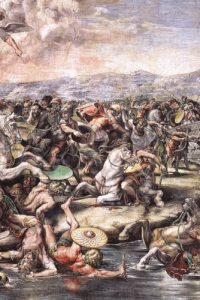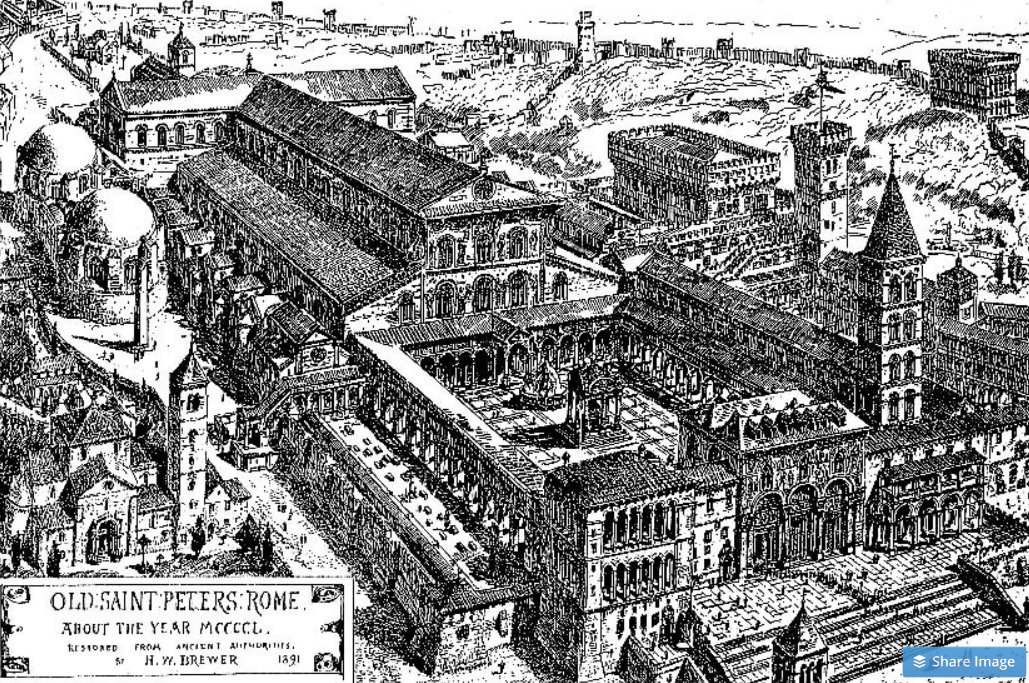The above is a drawing of Old St. Peter's, the building which had originally been built on the grounds of Nero's Circus in Rome, where many Christian martyrs had gone to their deaths, including St. Peter himself.
The catacombs under Nero's circus were used for the burial of the many enemies of Rome, criminals and Christians who died in the circus.
See a plan of Nero's circus below overlaid onto the plan of St. Peter's:
This site is where the first Christian martyrdoms in Rome took place in 65 A.D..
St. Peter is believed to have been crucified here in 67 A.D. along the spine of the circus with other Christians.
This is likely to have been a traumatic moment for Christians, as St. Peter had been with Christ during his mission and had been largely responsible for the rapid growth of Christianity in the decades following Christ's death.
Nero's Circus had been started by the Emperor Nero and finished by the emperor Caligula around 40 A.D.. It was a place of entertainment and cruelty, symbolic of the vicious nature of the Roman Empire.
An edict of toleration of Christianity was published in 311 A.D. and a second in 312 A.D., bringing to an end the persecution of Christians, but it is a long step from the ending of persecutions to the transfer of a huge and important tract of land and its buildings to the Christian church.
What we do know is that Old St. Peter's was started around 318 A.D., about 6 years after the victory of Constantine the Great over his rival for the western empire, the Emperor Maxentius. Old St. Peter's made use of some of the buildings that were part of Nero's Circus.
Why Constantine went this far, to grant this land, in his support for Christianity is a big question. To have won that battle in 312 A.D. required a pragmatic mind and the help of many groups, not just his legions.
My answer to this question, why did he go this far, is that Christians helped him to succeed. How they helped him on that fateful day in October, 312 A.D. is what I speculate on in my novel, The Road to the Bridge.
That battle has been the subject of many great works of art including the following by the master of the Italian Renaissance, Raphael, (died 1520.)
Speculation that Constantine saw a sign in the sky and had that sign painted on the shields of his legionaries, was most likely dreamt up afterwards, to present the victory as occurring with the support of God.
What the myth does reflect though is the real importance of the battle to the Christian church and the way it transformed that church.
To go from having your churches burnt and your members persecuted to being granted this site and many others, including the site of the Church of the Holy Sepulchre in Jerusalem, the location Jesus was believed to have been crucified, shows a major commitment to Christianity by Constantine.
You don't back one religion to such an extent for private reasons, I suggest, but for that religion's support for you winning power, and holding it.
The Christian church aligned itself fatefully with this emperor and ever since it has aligned itself with the state.
Whether this was a good thing, for the followers of someone who said, “there is more chance of a camel getting through the eye of a needle, than a rich man getting into heaven,” is something you can decide.
What I do believe is that without the lands of the Vatican the Catholic church right now would be a much diminished religious group. Perhaps the Catholic church might be renamed now as, Constantine's Catholic church? What do you think?
Laurence O'Bryan is the author of The Sign of the Blood (click here to learn more,) a novel about the rise to power of Constantine the Great, The Road to the Bridge (click here to learn more), about the lead up to the Battle of the Milvian Bridge and the final novel in the trilogy, The Cursed City (due late 2020), about the founding of Constantinople.
References:
If you are a writer or a publisher who wants to be featured visit BGSAuthors - our dedicated site for authors and publishers.






